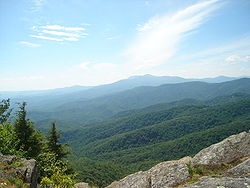Blue Ridge Mountains
| Blue Ridge Mountains | |
|---|---|
 The Blue Ridge Mountains as seen from the Blue Ridge Parkway near Mount Mitchell in North Carolina | |
| Highest point | |
| Peak | Mount Mitchell |
| Elevation | 6,684 ft (2,037 m) |
| Coordinates | 35°45′53″N 82°15′55″W / 35.76472°N 82.26528°W / 35.76472; -82.26528Coordinates: 35°45′53″N 82°15′55″W / 35.76472°N 82.26528°W / 35.76472; -82.26528 |
| Geography | |
 Appalachian Mountains | |
| Country | United States |
| States | List
|
| Parent range | Appalachian Mountains |
| Geology | |
| Orogeny | Grenville orogeny |
| Type of rock | granite, gneiss and limestone |
The Blue Ridge Mountains are a physiographic province of the larger Appalachian Mountains range. This province consists of northern and southern physiographic regions, which divide near the Roanoke River gap.[1] The mountain range is located in the eastern United States, and extends 550 miles southwest from southern Pennsylvania through Maryland, West Virginia, Virginia, South Carolina, Tennessee and Georgia.[2] To the west of the Blue Ridge, between it and the bulk of the Appalachians, lies the Great Appalachian Valley, bordered on the west by the Ridge and Valley province of the Appalachian range.
The Blue Ridge Mountains are noted for having a bluish color when seen from a distance. Trees put the "blue" in Blue Ridge, from the isoprene released into the atmosphere,[3] thereby contributing to the characteristic haze on the mountains and their distinctive color.[4]
Within the Blue Ridge province are two major national parks – the Shenandoah National Park in the northern section, and the Great Smoky Mountains National Park in the southern section – and eight national forests including George Washington and Jefferson National Forests, Cherokee National Forest, Pisgah National Forest, Nantahala National Forest and Chattahoochee National Forest. The Blue Ridge also contains the Blue Ridge Parkway, a 469-mile (755 km) long scenic highway that connects the two parks and is located along the ridge crest-lines with the Appalachian Trail.[5]
Contents
1 Geography
2 Geology
3 History
4 Flora and fauna
4.1 Flora
4.2 Fauna
5 In music
6 See also
7 References
8 External links
Geography
Although the term "Blue Ridge" is sometimes applied exclusively to the eastern edge or front range of the Appalachian Mountains, the geological definition of the Blue Ridge province extends westward to the Ridge and Valley area, encompassing the Great Smoky Mountains, the Great Balsams, the Roans, the Blacks, the Brushy Mountains (a "spur" of the Blue Ridge) and other mountain ranges.

The Blue Ridge Mountains as seen from Blowing Rock, North Carolina.
The Blue Ridge extends as far north into Pennsylvania as South Mountain. While South Mountain dwindles to mere hills between Gettysburg and Harrisburg, the band of ancient rocks that form the core of the Blue Ridge continues northeast through the New Jersey and Hudson River highlands, eventually reaching The Berkshires of Massachusetts and the Green Mountains of Vermont.
The Blue Ridge contains the highest mountains in eastern North America south of Baffin Island. About 125 peaks
exceed 5,000 feet (1,500 m) in elevation.[6] The highest peak in the Blue Ridge (and in the entire Appalachian chain) is Mt. Mitchell in North Carolina at 6,684 feet (2,037 m). There are 39 peaks in North Carolina and Tennessee higher than 6,000 feet (1,800 m); by comparison, in the northern portion of the Appalachian chain only New Hampshire's Mt. Washington rises above 6,000 feet. Southern Sixers is a term used by peak baggers for this group of mountains.[7]
The Blue Ridge Parkway runs 469 miles (755 km) along crests of the Southern Appalachians and links two national parks: Shenandoah and Great Smoky Mountains. In many places along the parkway, there are metamorphic rocks (gneiss) with folded bands of light-and dark-colored minerals, which sometimes look like the folds and swirls in a marble cake.
Geology

Blue Ridge Mountains, viewed from Chimney Rock Mountain Overlook in North Carolina
Most of the rocks that form the Blue Ridge Mountains are ancient granitic charnockites, metamorphosed volcanic formations, and sedimentary limestone. Recent studies completed by Richard Tollo, a professor and geologist at George Washington University, provide greater insight into the petrologic and geochronologic history of the Blue Ridge basement suites. Modern studies have found that the basement geology of the Blue Ridge is made of compositionally unique gneisses and granitoids, including orthopyroxene-bearing charockites. Analysis of zircon minerals in the granite completed by John Aleinikoff at the U.S. Geological Survey has provided more detailed emplacement ages.

The northernmost extension of the Blue Ridge Mountains, in northern Maryland
Many of the features found in the Blue Ridge and documented by Tollo and others have confirmed that the rocks exhibit many similar features in other North American Grenville-age terranes. The lack of a calc-alkaline affinity and zircon ages less than 1,200 Ma suggest that the Blue Ridge is distinct from the Adirondacks, Green Mountains, and possibly the New York-New Jersey Highlands. The petrologic and geochronologic data suggest that the Blue Ridge basement is a composite orogenic crust that was emplaced during several episodes from a crustal magma source. Field relationships further illustrate that rocks emplaced prior to 1,078–1,064 Ma preserve deformational features. Those emplaced post-1,064 Ma generally have a massive texture and missed the main episode of Mesoproterozoic compression.[8]
The Blue Ridge Mountains began forming during the Silurian Period over 400 million years ago. Approximately 320 Mya, North America, and Europe collided, pushing up the Blue Ridge. At the time of their emergence, the Blue Ridge were among the highest mountains in the world and reached heights comparable to the much younger Alps. Today, due to weathering and erosion over hundreds of millions of years, the highest peak in the range, Mount Mitchell in North Carolina, is only 6,684 feet high – still the highest peak east of the Rockies.
History

The Blue Ridge Mountains in the background from Lynchburg, Virginia
The English who settled colonial Virginia in the early 17th century recorded that the native Powhatan name for the Blue Ridge was Quirank. At the foot of the Blue Ridge, various tribes including the Siouan Manahoacs, the Iroquois, and the Shawnee hunted and fished. A German physician-explorer, John Lederer, first reached the crest of the Blue Ridge in 1669 and again the following year; he also recorded the Virginia Siouan name for the Blue Ridge (Ahkonshuck).
At the Treaty of Albany negotiated by Lieutenant Governor Alexander Spotswood (1676–1740), of Virginia with the Iroquois between 1718 and 1722, the Iroquois ceded lands they had conquered south of the Potomac River and east of the Blue Ridge to the Virginia Colony. This treaty made the Blue Ridge the new demarcation point between the areas and tribes subject to the Six Nations, and those tributaries to the Colony. When colonists began to disregard this by crossing the Blue Ridge and settling in the Shenandoah Valley in the 1730s, the Iroquois began to object, finally selling their rights to the Valley, on the west side of the Blue Ridge, at the Treaty of Lancaster in 1744.
During the Gettysburg Campaign of the American Civil War, the Army of Northern Virginia, Robert E. Lee commanding, slipped across the Potomac to begin the second invasion of the North. They moved slowly across the Blue Ridge, using the mountains to screen their movements.
Flora and fauna
The forest environment provides natural habitat for many plants, trees, and animals.
Flora
The Blue Ridge Mountains have stunted oak and oak-hickory forest habitats, which comprise most of the Appalachian slope forests. Flora also includes grass, shrubs, hemlock and mixed-oak pine forests.[9]
While the Blue Ridge range includes the highest summits in the eastern United States, the climate is nevertheless too warm to support an alpine zone, and thus the range lacks the tree line found at lower elevations in the northern half of the Appalachian range. The highest parts of the Blue Ridge are generally vegetated in dense Southern Appalachian spruce-fir forests.[citation needed]
Fauna
The area is host to many animals, including:[9]
- Many species of amphibians and reptiles
- A large diversity of fish species, many of which are endemic
- American black bear
Songbirds and other bird species- Bobcat
- Coyote
- Red fox
- Gray fox
- Grouse
- Whitetail deer
- Wild boar
- Wild turkey
In music
- "The Trail of the Lonesome Pine" (as published in 1913) was recorded by Stan Laurel and Oliver Hardy and featured in their 1937 film Way Out West. This version of the song climbed to the number 2 in the UK Singles Chart in 1975.[10]
- A well known song about the Blue Ridge is "My Home's Across the Blue Ridge Mountains", first recorded by the Carolina Tar Heels (1929), later by the Carter Family (1937), and still later by others, including Doc Watson and Joan Baez.[citation needed]
- The bluegrass song, "Blue Ridge Cabin Home", was performed and recorded by many artists,[citation needed] including Flatt and Scruggs.
- The Clemson University alma mater[11] opens with the line, "Where the Blue Ridge yawns its greatness...", in reference to the school's location at foot of the mountains.
- West Virginia's state song, Take Me Home, Country Roads by John Denver, prominently mentions the Blue Ridge Mountains along with the Shenandoah River.[12]
See also
- Appalachian balds
- Appalachian bogs
- Appalachian temperate rainforest
- Appalachian-Blue Ridge forests
- Cove (Appalachian Mountains)
References
^ "Physiographic divisions of the conterminous U. S." U.S. Geological Survey. Retrieved December 6, 2007..mw-parser-output cite.citation{font-style:inherit}.mw-parser-output q{quotes:"""""""'""'"}.mw-parser-output code.cs1-code{color:inherit;background:inherit;border:inherit;padding:inherit}.mw-parser-output .cs1-lock-free a{background:url("//upload.wikimedia.org/wikipedia/commons/thumb/6/65/Lock-green.svg/9px-Lock-green.svg.png")no-repeat;background-position:right .1em center}.mw-parser-output .cs1-lock-limited a,.mw-parser-output .cs1-lock-registration a{background:url("//upload.wikimedia.org/wikipedia/commons/thumb/d/d6/Lock-gray-alt-2.svg/9px-Lock-gray-alt-2.svg.png")no-repeat;background-position:right .1em center}.mw-parser-output .cs1-lock-subscription a{background:url("//upload.wikimedia.org/wikipedia/commons/thumb/a/aa/Lock-red-alt-2.svg/9px-Lock-red-alt-2.svg.png")no-repeat;background-position:right .1em center}.mw-parser-output .cs1-subscription,.mw-parser-output .cs1-registration{color:#555}.mw-parser-output .cs1-subscription span,.mw-parser-output .cs1-registration span{border-bottom:1px dotted;cursor:help}.mw-parser-output .cs1-hidden-error{display:none;font-size:100%}.mw-parser-output .cs1-visible-error{font-size:100%}.mw-parser-output .cs1-subscription,.mw-parser-output .cs1-registration,.mw-parser-output .cs1-format{font-size:95%}.mw-parser-output .cs1-kern-left,.mw-parser-output .cs1-kern-wl-left{padding-left:0.2em}.mw-parser-output .cs1-kern-right,.mw-parser-output .cs1-kern-wl-right{padding-right:0.2em}
^ "Blue Ridge". U.S. Geological Survey. Retrieved December 19, 2018.
^ Johnson, A. W (1998). Invitation To Organic Chemistry. Jones & Bartlett Learning. p. 261. ISBN 978-0-7637-0432-2.
^ "Blue Ridge Parkway, Frequently Asked Questions". National Park Service. 2007. Retrieved December 29, 2007.
^ Leighty, Dr. Robert D. (2001). "Blue Ridge Physiographic Province". Contract Report. Defense Advanced Research Projects Agency (DOD) Information Sciences Office. Retrieved December 29, 2007.
^ Medina, M.A.; J.C. Reid; R.H. Carpenter (2004). "Physiography of North Carolina" (PDF). North Carolina Geological Survey, Division of Land Resources. Retrieved December 29, 2007.
^ South Beyond 6000
^ Tollo, Richard P.; Aleinkoff, John N.; Borduas, Elizabeth A. (2004). "Petrology and Geochronology of Grenville-Age Magmatism, Blue Ridge Province, Northern Virginia". Northeastern Section (39th Annual) and Southeastern Section (53rd Annual) Joint Meeting. Geological Society of America.
^ ab "Blue Ridge Mountains". The New Georgia Encyclopedia. Retrieved 4 September 2016.
^ Roberts, David (2006). British Hit Singles & Albums (19th ed.). London: Guinness World Records Limited. p. 314. ISBN 1-904994-10-5.
^ "Clemson University Alma Mater". Clemson.edu. Retrieved May 24, 2018.
^ https://www.songfacts.com/lyrics/john-denver/take-me-home-country-roads
- Olson, Ted (1998). Blue Ridge Folklife, University Press of Mississippi.
ISBN 1-57806-023-0.
External links
 Blue Ridge Mountains travel guide from Wikivoyage
Blue Ridge Mountains travel guide from Wikivoyage





